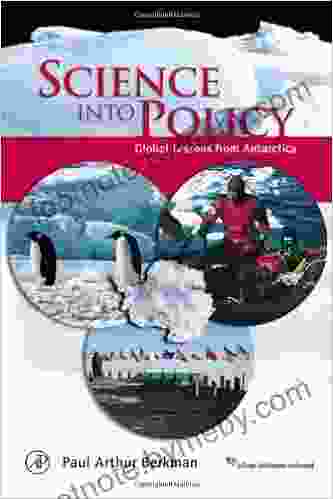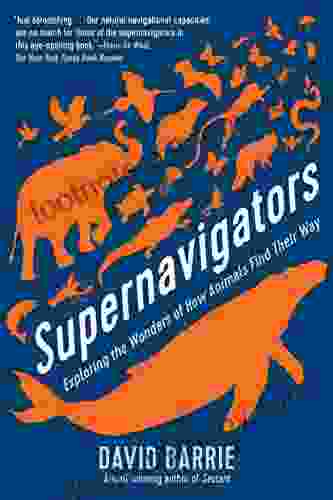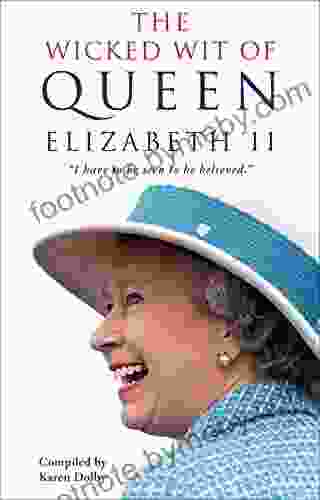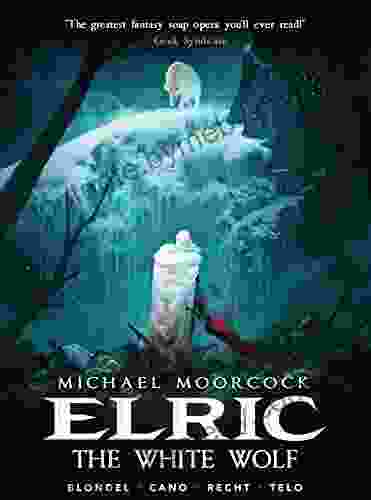Exploring The Wonders of How Animals Find Their Way: Unlocking the Secrets of Animal Navigation

Animals possess an extraordinary ability to navigate their surroundings, finding their way across vast distances and treacherous terrains with remarkable precision. From the celestial compass of birds to the magnetic sense of turtles, each species has evolved unique strategies to guide their journeys. In this comprehensive guide, we will delve into the fascinating world of animal navigation, uncovering the wonders of their remarkable adaptations and the profound implications for our understanding of the natural world.
The Celestial Compass of Birds
Birds are renowned for their exceptional navigational abilities, which allow them to undertake epic migrations across continents and oceans. At the heart of their navigational prowess lies a sophisticated celestial compass, an internal mechanism that enables them to perceive the Earth's magnetic field and use it as a reference point.
4.5 out of 5
| Language | : | English |
| File size | : | 4561 KB |
| Text-to-Speech | : | Enabled |
| Screen Reader | : | Supported |
| Enhanced typesetting | : | Enabled |
| Word Wise | : | Enabled |
| Print length | : | 320 pages |
| Lending | : | Enabled |
Birds possess specialized cells in their eyes that contain magnetic receptors, allowing them to sense the direction and intensity of the magnetic field. This sensory information is integrated with visual cues and other environmental factors, enabling birds to determine their position and orientation relative to their destination.
The Magnetic Sense of Turtles
Marine turtles also exhibit an extraordinary navigational sense, enabling them to undertake long-distance migrations across the open ocean. Their ability to navigate these vast expanses stems from a highly developed magnetic sense.
Turtles possess magnetite crystals in their heads that align with the Earth's magnetic field. This alignment provides them with directional information, allowing them to determine their latitude and longitude. By combining this magnetic sense with other cues, such as ocean currents and landmarks, turtles can navigate vast distances with remarkable accuracy.
The Olfactory Compass of Salmon
Salmon are known for their remarkable ability to return to their natal streams after spending years in the ocean. This extraordinary homing instinct is guided by an olfactory compass, a sophisticated sense of smell that enables them to detect and follow the unique chemical signature of their home stream.
Salmon imprint on the chemical composition of their natal stream as juveniles. When they return from the ocean to spawn, they use their olfactory sense to navigate back to their birthplace. By following the scent trail of their home stream, salmon can traverse vast distances with remarkable precision.
The Visual Navigation of Insects
Insects also possess remarkable navigational abilities, despite their diminutive size and limited cognitive capacity. Many insects rely on visual cues to navigate their surroundings, using landmarks and other visual references to guide their journeys.
Honeybees, for example, use a combination of visual landmarks and the sun's position to navigate back to their hive. They can memorize the location of their hive relative to landmarks and use the sun's position to determine their direction of travel.
The Social Navigation of Animals
Some animals have developed social navigation strategies, relying on the knowledge and experience of others to find their way. This is particularly evident in social animals, such as wolves and elephants, which often follow the lead of experienced individuals.
Wolves, for example, establish a pack hierarchy in which the alpha pair leads the group. The alpha pair possesses a wealth of knowledge about the territory and uses this knowledge to guide the pack's movements. Other pack members follow the alpha pair, relying on their experience and leadership to navigate safely and efficiently.
The Implications of Animal Navigation
The study of animal navigation has profound implications for our understanding of the natural world. By unraveling the secrets of how animals find their way, we gain insights into the remarkable adaptations and cognitive abilities of different species.
Moreover, the principles of animal navigation have practical applications in various fields, including robotics and navigation systems. By mimicking the navigational strategies of animals, scientists and engineers can develop new technologies that are more efficient, reliable, and environmentally friendly.
The world of animal navigation is a testament to the extraordinary diversity and complexity of life on Earth. From the celestial compass of birds to the magnetic sense of turtles, each species has evolved unique strategies to find their way through the challenges of their environment.
By exploring the wonders of animal navigation, we not only gain a deeper appreciation for the natural world but also uncover valuable insights that can inspire innovation and advance our understanding of the intricate workings of life.
4.5 out of 5
| Language | : | English |
| File size | : | 4561 KB |
| Text-to-Speech | : | Enabled |
| Screen Reader | : | Supported |
| Enhanced typesetting | : | Enabled |
| Word Wise | : | Enabled |
| Print length | : | 320 pages |
| Lending | : | Enabled |
Do you want to contribute by writing guest posts on this blog?
Please contact us and send us a resume of previous articles that you have written.
 Book
Book Novel
Novel Page
Page Chapter
Chapter Text
Text Story
Story Genre
Genre Reader
Reader Library
Library Paperback
Paperback E-book
E-book Magazine
Magazine Newspaper
Newspaper Paragraph
Paragraph Sentence
Sentence Bookmark
Bookmark Shelf
Shelf Glossary
Glossary Bibliography
Bibliography Foreword
Foreword Preface
Preface Synopsis
Synopsis Annotation
Annotation Footnote
Footnote Manuscript
Manuscript Scroll
Scroll Codex
Codex Tome
Tome Bestseller
Bestseller Classics
Classics Library card
Library card Narrative
Narrative Biography
Biography Autobiography
Autobiography Memoir
Memoir Reference
Reference Encyclopedia
Encyclopedia David Mcgowan
David Mcgowan David Cannon
David Cannon Dave Bio Baranek
Dave Bio Baranek Debbie S Miller
Debbie S Miller Deb Curtis
Deb Curtis David Drake
David Drake David H Hendrickson
David H Hendrickson David Leddick
David Leddick John Kreiter
John Kreiter Bolu Babalola
Bolu Babalola David Gonzalez
David Gonzalez Alicia Beckton
Alicia Beckton Carolyn Forche
Carolyn Forche David R Contosta
David R Contosta David Baldacci
David Baldacci David Soman
David Soman Patricia Brady
Patricia Brady David Jamieson Bolder
David Jamieson Bolder David Chadwick
David Chadwick Stephen Kantrowitz
Stephen Kantrowitz
Light bulbAdvertise smarter! Our strategic ad space ensures maximum exposure. Reserve your spot today!

 Darrell PowellFeeling Good: The New Mood Therapy - Conquer Depression and Anxiety Naturally
Darrell PowellFeeling Good: The New Mood Therapy - Conquer Depression and Anxiety Naturally
 Chris ColemanScience Into Policy: Global Lessons From Antarctica - A Must-Read Guide to...
Chris ColemanScience Into Policy: Global Lessons From Antarctica - A Must-Read Guide to...
 Carlos FuentesImmerse Yourself in the Beguiling Beauty of Nature In the Eye of the Beholder
Carlos FuentesImmerse Yourself in the Beguiling Beauty of Nature In the Eye of the Beholder George Bernard ShawFollow ·11.3k
George Bernard ShawFollow ·11.3k Harvey BellFollow ·15k
Harvey BellFollow ·15k Neil GaimanFollow ·2k
Neil GaimanFollow ·2k Cody RussellFollow ·17.8k
Cody RussellFollow ·17.8k Dalton FosterFollow ·4.2k
Dalton FosterFollow ·4.2k Owen SimmonsFollow ·7.5k
Owen SimmonsFollow ·7.5k Arthur MasonFollow ·10.6k
Arthur MasonFollow ·10.6k Ashton ReedFollow ·11.9k
Ashton ReedFollow ·11.9k

 Jayden Cox
Jayden CoxFaith Lies and the War on Terror: Exposing the Truth...
In the aftermath of the 9/11...

 Jack Powell
Jack PowellMad About the Trump Era: Mad Magazine 2024
The Trump...

 Warren Bell
Warren BellYou Got This: Tips for Women Who Want to Rock at Real...
Real estate...

 Ernest Cline
Ernest ClineThe Daring Life and Turbulent Times of the Original Girl...
: Embracing the Spirit of Adventure In...
4.5 out of 5
| Language | : | English |
| File size | : | 4561 KB |
| Text-to-Speech | : | Enabled |
| Screen Reader | : | Supported |
| Enhanced typesetting | : | Enabled |
| Word Wise | : | Enabled |
| Print length | : | 320 pages |
| Lending | : | Enabled |










